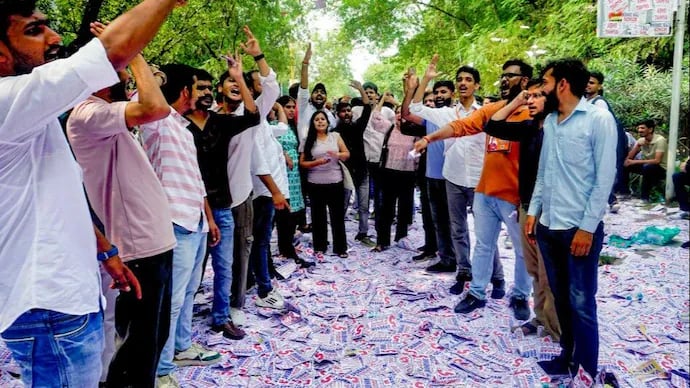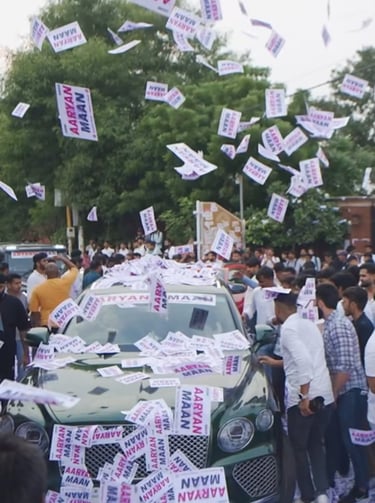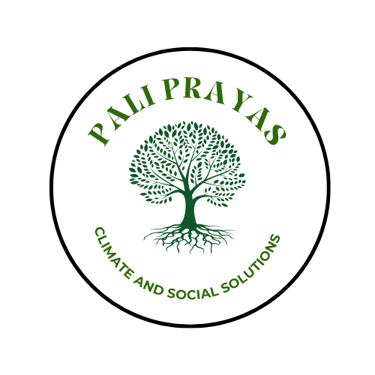The Climate Cost of DUSU Election
Delhi University election produces a staggering more than 1200 tonnes of Carbon emission.
CLIMATE CHANGE


When you walk onto the Delhi University campus during Delhi University Student Union (DUSU) election season, the whole place feels alive with energy. The 2024 DUSU elections, with nominations closing on September 17 and voting on the 27th, have turned the campus into a frenzy of activity. The normally laid-back campus takes on a different vibe that makes you feel like you’ve stepped into the midst of a real-life election campaign. When you step into the middle of it all, it’s easy to get caught up in the excitement and it makes you feel like you’re part of something big.
But then, as you look around, you start to see the other side of it. The streets are littered with discarded pamphlets, and the banners once used look like heaps of waste waiting to pile up. The convoys are not just a show of strength—they’re spewing harmful emissions into the air we breathe. For all the enthusiasm that surrounds the DUSU elections, it’s hard to shake the feeling that the cost we’re paying, especially to the environment, is far too high. Behind this seemingly grand display of democracy lies a hidden cost. This student election, fueled by waste and pollution, contributes to the very climate crisis students should be fighting against. Each pamphlet thrown into the air, each vehicle in those roaring convoys, comes at a price. And that price is being paid by the planet.
Vehicle Emission of Convoys and Mountains of Paper Waste
Take, for instance, the convoys themselves. Each candidate, eager to show strength and power, moves around with fleets of cars and bikes. It’s not uncommon for just one candidate to have a convoy of 20-30 vehicles following them for days on end. Multiply that by all the candidates running for various posts, and suddenly you have over a thousand vehicles clogging the streets of the campus, running day and night. These vehicles consume gallons of diesel—roughly 10 liters per vehicle per day—and with each liter of diesel burned, 2.7 kg of carbon dioxide is pumped into the atmosphere. It’s a cycle of emissions that builds up rapidly: with 1,000 vehicles over a campaign period of 45 days, the university produces a staggering 1,210 tonnes of CO2 emissions. In the middle of a climate crisis, these numbers are more than just statistics—they represent real harm to the air we breathe, the weather patterns we rely on, and the future of the planet.
And it’s not just the vehicles. The amount of paper used during these elections is overwhelming. Everywhere you turn, there’s another poster, another pamphlet, another banner hanging on walls or trees. According to the Central Pollution Control Board (CPCB), it takes about 324 liters of water to produce just 1 kg of paper and an A4 sheet requires about 10 liters. With 93% of paper globally sourced from trees, it’s clear that the environmental toll of these materials is immense. Imagine thousands of flyers and posters being printed for just one candidate—and then multiply that by all the candidates running in the election.
Yet, during DUSU elections, students casually throw tonnes of paper onto the ground as though it’s part of the show. This behavior not only disrespects the environment but also raises serious questions about the kind of education students at a prestigious university like Delhi are receiving. If the future leaders of our country, the students of a central university, cannot grasp the importance of something as basic as waste reduction, what message does that send about the broader fight against climate change?
Every student in the university, and even those in the surrounding community, can see that something is amiss in the way these elections are conducted. The piles of waste, the incessant vehicle fumes, and the mountains of paper strewn across the campus are obvious indicators that something is wrong. Yet, despite this awareness, students still find themselves amalgamated into the very process they recognize as flawed.
One such candidate, Zaffar Malik Iqbal, who is running for Secretary at Law Centre 2 in Delhi University, offers a poignant perspective on the election process. Zaffar says, “When I started my campaign for Secretary at Law Centre 2, I had a clear plan. I wanted to run an eco-friendly, merit-based campaign focused on personal outreach. I truly believe in choosing candidates based on their abilities, not on regionalism, religion, or racism. But as the election date gets closer, I’m finding it hard to stick to this plan. The reality is that I’m being pulled into the same high-energy, wasteful tactics that everyone else is using. The truth is, students seem to be more interested in muscle power and flashy displays than in genuine, sustainable approaches. It’s frustrating because I feel like I have no choice but to follow the same path, even though it goes against everything I wanted my campaign to stand for.”
Malik Zaffar Iqbal with his team at LC-2
The Failure of Regulations and Broader Implications
It’s not like there haven’t been efforts to curb this waste. The National Green Tribunal (NGT), recognizing the environmental damage caused by such elections, passed a ruling in 2016 that sought to limit the use of paper and plastic. The order specifically restricted candidates to using handmade posters, limiting them to just two posters on each campus. Additionally, the Lyngdoh Committee, which oversees student elections, emphasized the need for sustainable campaigning, with a clear directive against mass-produced banners and posters. Yet, these rulings have largely fallen by the wayside. The university authorities, despite these guidelines, have failed to enforce them, and every election season, the same excessive use of paper and plastic continues. It’s as if the rules exist only on paper—ironic, given how much paper is wasted during these elections.
What’s even more concerning is that this failure at the university level reflects a much larger issue. The Election Commission of India (ECI) has been running green campaign initiatives for years, trying to reduce the environmental impact of elections across the country. These initiatives include using biodegradable banners, reducing paper waste, and promoting digital campaigning. But if these green practices can’t even be implemented in a university election—where the scale is relatively small—how can we expect them to be effective at the national level? If we can’t hold a student election without contributing to climate change, what hope do we have for making our national elections more sustainable?
A Cycle of Waste and Pollution
Every year, we watch as the same cycle repeats itself. The excitement builds, the campaigns roll on, and yet no one seems to acknowledge the mess left behind. It’s almost as if the environmental damage has become part of the tradition—something we ignore in favor of the immediate thrill of the elections. But with climate change becoming an urgent global crisis, can we really afford to keep doing things this way?
It’s disheartening to witness how the education system of this country—meant to cultivate responsible, conscientious citizens—fails to instill the values of environmental sustainability in its future leaders. Instead, the focus remains on the immediate win, while the long-term consequences are ignored. The sad reality is that while DUSU elections may seem like a localized event, their environmental impact ripples far beyond the campus. From the trees cut down to make paper, to the water wasted, to the plastic that will never decompose, to the harmful emissions from the convoys, the cost is being paid by the Earth. It’s a reminder that our democratic processes, while essential, must evolve to meet the challenges of the modern world—chief among them, the fight against climate change.
As students, as voters, as citizens, it’s time to start thinking about the broader impact of our actions. DUSU elections should be an opportunity not just to choose our representatives but to demonstrate the kind of leadership that respects the environment and looks toward the future. The power to make elections greener is in our hands—it’s time we start using it.




